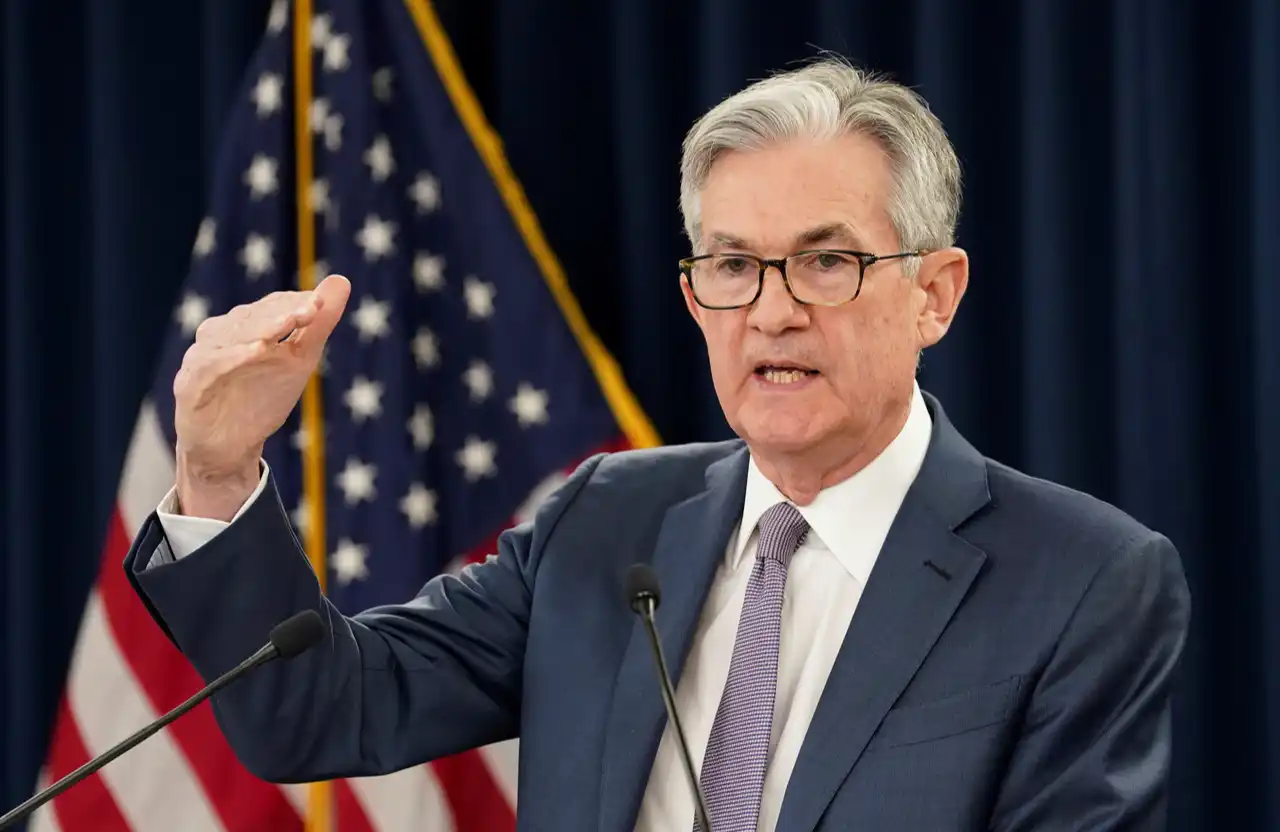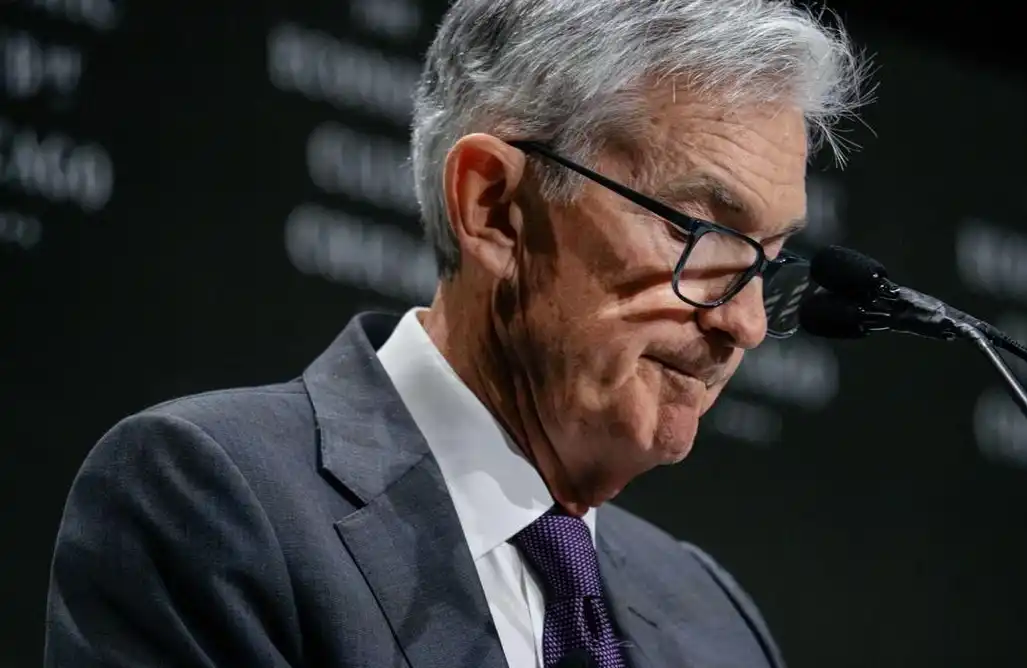Federal Reserve's most important speech of the year, high probability of rate cut in September
「The risk balance is shifting.」 When Federal Reserve Chairman Jerome Powell uttered these words at Jackson Hole, the global financial markets instantly tensed up. This was Powell's final speech at this global central bank summit during his tenure, facing the most complex policy environment. Inflation is resurging, job growth is sharply slowing, and the new government's tariff policies are driving up prices — the Fed is at an unprecedented crossroads.

The data is alarming, with July job growth plummeting to an average of 35,000 jobs per month, only a fifth of 2024's figure; core inflation rising to 2.9%, well above the Fed's 2% target; and the tariff effects starting to show, with a 1.1% increase in commodity prices. Behind these numbers is a profound transformation taking place in the U.S. economy. More worrisome is Powell's first public acknowledgment of a "challenging situation" — upward inflation risk and downward employment risk.
This dual pressure has put traditional monetary policy tools in a dilemma — raising rates could further hit employment, while lowering rates could drive up inflation. "We will never allow a one-time price level increase to turn into a persistent inflation problem." Powell's statement is not only a commitment to the market but also exposes the Fed's inner anxiety.
For the crypto market, these macro signals are far more than background noise. Over the past two years, the price volatility of digital assets has been highly dependent on the ebb and flow of dollar liquidity and U.S. bond yields. Powell's statement "The risk balance is shifting" implies that the liquidity environment critical for the crypto market's survival is reaching a turning point. With limited room for rate hikes and rate cuts constrained by inflation, the market is starting to realize that uncertainty itself is the new certainty.

In this speech known as the "curtain call," Powell also announced a significant adjustment to the Fed's monetary policy framework — the first revision since 2020. The new framework emphasizes the "inclusive" employment target, providing greater flexibility for policy adjustments. However, the problem is that even the most flexible framework will struggle to provide ready-made answers in the face of the current complexity. For speculative crypto assets, this means that market narratives and risk appetite fluctuations will be more intense than ever before.
The tariff shadow is reshaping the U.S. economic landscape. Powell admitted, "Significantly higher tariffs are reshaping the global trading system," and their impact on consumer prices is "now clearly visible." This is not just a description of economic reality but also a warning to policymakers: monetary policy must find a balance between political pressure and economic principles. For the crypto market, this is also a reminder — every swing in macro policy will quickly map onto the flow of funds and valuation logic of risk assets.
The market is holding its breath awaiting the next move by the Federal Reserve. The expectation for a rate cut in September remains strong, but Powell's speech indicates that this decision will be more challenging than ever. Caught between inflation and employment, the Fed is seeking a path never before taken; and as global capital seeks hedge and refuge, crypto assets may also take on a new role on this uncharted road.
Below is the full text of the speech:
This year, against the backdrop of widespread changes in economic policy, the U.S. economy has shown resilience. With regard to the Fed's dual mandate goals, the labor market remains close to full employment, and while inflation remains somewhat elevated, it has fallen significantly from its post-pandemic peak. At the same time, the balance of risks appears to be shifting.
In my speech today, I will first discuss the current economic situation and the near-term outlook for monetary policy. Then, I will turn to the results of our second monetary policy framework public review as reflected in our revised "Statement on Longer-Run Goals and Monetary Policy Strategy" released today.
Current Economic Conditions and Near-Term Outlook
A year ago when I stood at this podium, the economy was at a turning point. Our policy rate had been held steady at a level between 5.25% and 5.5% for over a year. This restrictive policy stance was appropriate, helping to bring down inflation and promote a sustainable balance between aggregate demand and aggregate supply. Inflation was very close to our target, and the labor market had cooled off from its previous overheated state. The upside risks to inflation had diminished. However, the unemployment rate had risen by nearly a percentage point, a situation that had not occurred historically except during recessions. In the subsequent three Federal Open Market Committee (FOMC) meetings, we recalibrated our policy stance, laying the foundation for the past year's labor market to balance near full employment (Chart 1).
This year, the economy faces new challenges. Tariffs raised significantly among our trading partners are reshaping the global trading system. Tighter immigration policies have led to a sudden slowdown in labor force growth. Looking further ahead, changes in tax, spending, and regulatory policies could also have significant effects on economic growth and productivity. The ultimate direction of all these policies and their lasting effects on the economy carry enormous uncertainty.
Changes in trade and immigration policies are affecting both demand and supply simultaneously. In this environment, distinguishing between cyclical developments and structural developments is difficult. This distinction is critical because monetary policy can strive to stabilize cyclical fluctuations but is powerless to address structural changes.
The labor market is a prime example. The July employment report released earlier this month showed that over the past three months, average monthly job gains slowed to just 35,000, below the 168,000 per month during the 2024 period (Chart 2). This slowdown is much greater than the assessment just a month ago, as May and June's early data were significantly revised downward. However, this does not appear to have led to the significant slack in the labor market that we hoped to avoid. While the unemployment rate ticked up in July, it remains at a historic low of 4.2% and has stayed relatively stable over the past year. Other labor market indicators have shown little change or only modest softening, including quits, layoffs, job vacancies, and the unemployed-to-job openings ratio, as well as nominal wage growth. Labor supply and demand have softened concurrently, significantly reducing the "breakeven" job creation rate needed to maintain the unemployment rate. In fact, with the sharp drop in immigration numbers, labor force growth has slowed significantly this year, and the labor force participation rate has declined in recent months.
Overall, although the labor market appears to be in a balanced state, this is a peculiar balance brought about by a significant slowdown in both labor supply and demand. This unusual situation suggests that the downside risks to employment are increasing. And if these risks materialize, they could quickly manifest in the form of a sharp increase in layoffs and rising unemployment rates.
At the same time, GDP growth in the first half of this year has slowed significantly to 1.2%, about half of the 2.5% pace projected for 2024 (Figure 3). The slowdown in growth is primarily attributed to a deceleration in consumer spending. Similar to the labor market, the partial deceleration in GDP may reflect a slowdown in supply or potential output growth.
Turning to inflation, higher tariffs have started to push up prices in certain categories of goods. Estimates based on the latest available data indicate that over the 12 months ending in July, overall PCE prices rose by 2.6%. Excluding the volatile food and energy categories, core PCE prices increased by 2.9%, higher than a year ago. Within core inflation, over the past 12 months, goods prices increased by 1.1%, marking a significant turnaround from the modest decline seen during 2024. In contrast, inflation in housing services continues to decline, while the level of non-housing services inflation remains slightly above historical levels consistent with 2% inflation (Figure 4).
The impact of tariffs on consumer prices is now clearly visible. We expect these effects to accumulate over the coming months, but the timing and magnitude are highly uncertain. For monetary policy, the key issue is whether these price increases could substantially raise the risk of persistent inflationary pressures. A reasonable baseline scenario is that the impact will be relatively short-lived—a one-time adjustment in price levels. Of course, "one-time" does not mean "one and done." It takes time for tariff increases to transmit through the entire supply chain and distribution network. Moreover, tariff rates are still changing, which could prolong the adjustment process.
However, the upward price pressures from tariffs could also trigger a more sustained inflation dynamics, posing a risk that needs to be assessed and managed. One possibility is that workers facing a decline in real income due to price hikes may demand and secure higher wage increases from employers, leading to an unfavorable wage-price dynamic. Given that the labor market is not particularly tight and is facing increasing downside risks, this outcome seems unlikely.
Another possibility is that inflation expectations could rise, driving actual inflation higher. Inflation has been persistently above our target for over four years and remains a prominent concern for households and businesses. However, indicators based on market and survey data suggest that long-term inflation expectations still appear well-anchored and consistent with our 2% long-term inflation goal.
Of course, we cannot take for granted that inflation expectations will remain stable. Whatever happens, we will not allow a one-time surge in price levels to evolve into a persistent inflation issue.
Overall, what does this imply for monetary policy? In the short term, the inflation risk leans toward the upside, while the employment risk leans toward the downside—a challenging situation. When our goals are strained in this way, our framework requires us to balance on both fronts of our dual mandate. Our policy rate is now about 100 basis points closer to the neutral level than a year ago, and the stability of the unemployment rate and other labor market indicators allows us to proceed with caution when considering a policy shift. Nevertheless, in a situation where the policy is in a restrictive range, the baseline outlook and the evolving risk balance may require us to adjust our policy stance.
Monetary policy has no preset path. Members of the Federal Open Market Committee will make these decisions based solely on their assessment of the data and its implications for economic outlook and risk balance. We will never deviate from this approach.
Evolution of the Monetary Policy Framework
Turning to my second topic, our monetary policy framework is built on the unchanging mission granted to us by Congress to promote maximum employment and stable prices for the American people. We remain fully committed to fulfilling our statutory mandate, and revisions to our framework will support this mandate under a wide range of economic conditions. Our revised "Statement on Longer-Run Goals and Monetary Policy Strategy," what we call the consensus statement, describes how we pursue our dual mandate goals. It is designed to provide the public with a clear understanding of how we think about monetary policy, a understanding that is crucial for transparency and accountability, as well as for making monetary policy more effective.
The changes we have made in this assessment are a natural evolution rooted in our deepening understanding of the economy. We continue to build on the foundation laid by the initial consensus statement led by Chair Ben Bernanke in 2012. Today's revised statement is the outcome of the second public review of our framework, which we conduct every five years. This year's review included three elements: "Fed Listens" events held at all Reserve Banks, a flagship research conference, and discussions and deliberations by policymakers supported by staff analysis at a series of FOMC meetings.
One key goal of this year's review was to ensure that our framework is applicable to a wide range of economic conditions. At the same time, the framework needs to evolve as economic structures change and as our understanding of these changes deepens. The challenges posed by the Great Depression are different from those of periods of high inflation and high accommodation, and these are different from the challenges we face today.
In our last assessment, we were living in a new normal characterized by interest rates near the Effective Lower Bound (ELB), accompanied by low growth, low inflation, and a very flat Phillips curve—meaning that inflation was not very responsive to economic slack. For me, a statistic that captures the essence of that era is that since the global financial crisis (GFC) erupted at the end of 2008, our policy rate stayed at the Effective Lower Bound for a record seven years. Many of you will remember the pain of that era, marked by weak growth and an extremely slow recovery. At that time, it seemed highly likely that even a mild recession would quickly push our policy rate back to the Effective Lower Bound, potentially keeping it there for an extended period. In such a scenario, inflation and inflation expectations could decline in a weak economy, pushing up real interest rates with nominal rates pinned near zero. Higher real rates would further weigh on job growth, exacerbate downward pressure on inflation and inflation expectations, triggering an adverse dynamic.
Those who pushed policy rates to the Effective Lower Bound and drove the 2020 framework change were considered rooted in slowly evolving global factors that were expected to persist for a long time—if not for the pandemic, they likely would have. The 2020 consensus statement included several features to address the increasingly prominent risks associated with the Effective Lower Bound over the past two decades. We emphasized the importance of anchoring long-term inflation expectations to support our dual objectives of price stability and full employment. Drawing on a vast body of literature on strategies to mitigate risks associated with the Effective Lower Bound, we adopted a flexible form of average inflation targeting—a "make-up" strategy to ensure that even under the constraint of the Effective Lower Bound, inflation expectations remain well-anchored. Specifically, we stated that after a period of persistently low inflation below 2%, appropriate monetary policy may aim for a period of moderately above 2% inflation.
As a result, the post-pandemic reopening period brought not low inflation and the Effective Lower Bound but the highest global inflation in 40 years. Like most other central banks and private sector analysts, until the end of 2021, we expected inflation to recede quite rapidly without a significant tightening of our policy stance (Figure 5). When it became clear that this was not the case, we responded forcefully, raising our policy rate by 5.25 percentage points over 16 months. This action, coupled with the easing of supply disruptions during the pandemic, helped bring inflation closer to our target without the painful rise in unemployment that has typically accompanied efforts to combat high inflation.
Elements of the Revised Consensus Statement
This year's assessment considered the evolution of the economic situation over the past five years. During this period, we saw that inflation dynamics can change rapidly in the face of significant shocks. Additionally, the current level of rates is much higher than the period between the global financial crisis and the pandemic. In a situation of inflation above target, our policy rate is restrictive—in my view, mildly restrictive. We cannot determine where rates will stabilize over the long term, but the neutral level is now likely higher than in the 2010s, reflecting changes in productivity, demographic structure, fiscal policy, and other factors influencing the balance of savings and investment (Figure 6). During the assessment, we discussed how the 2020 statement's focus on the Effective Lower Bound may have complicated our communication regarding our response to high inflation. We concluded that an emphasis on a set of overly specific economic conditions might have led to some confusion, hence we made several key modifications to the consensus statement to reflect this insight.
First, we have removed wording that implied the effective lower bound is a defining feature of the economic landscape. Instead, we note that our "monetary policy strategy is aimed at fostering maximum employment and stable prices under a wide range of economic conditions." The challenge of operating near the effective lower bound remains a potential concern, but it is not our primary focus. The revised statement reiterates that the Committee is prepared to use its full range of tools to achieve its employment and price stability goals, particularly in the event that the federal funds rate is constrained by the effective lower bound.
Second, we have returned to the framework of the flexible inflation-targeting regime and dropped the "makeup" strategy. The idea of intentionally allowing inflation to moderately overshoot has proven to be irrelevant. The inflation that has materialized in the months following our 2020 statement modification has been neither intentional nor moderate, as I acknowledged publicly in 2021.
Well-anchored inflation expectations are crucial for our success in reducing inflation without causing a sharp rise in the unemployment rate. Anchored expectations can facilitate a return to target inflation in the face of adverse inflation shocks and can limit the risk of deflation during economic weakness. Additionally, they allow monetary policy to support full employment during economic downturns without compromising price stability. Our revised statement emphasizes our commitment to taking forceful action to ensure that long-term inflation expectations remain well-anchored, serving both aspects of our dual mandate. The statement also notes that "price stability is the foundation of a sound and stable economy and supports the well-being of all Americans." This theme was loud and clear in our "Fed Listens" events. The past five years have painfully reminded us of the hardships brought by high inflation, especially for those least able to bear the higher costs of essentials.
Third, our 2020 statement stated that we would aim to mitigate "shortfalls" in full employment, rather than "deviations." The use of the term "shortfalls" reflects the view that our real-time assessment of the natural rate of unemployment—a.k.a. "full employment"—is highly uncertain. In the late stages of the recovery from the global financial crisis, employment remained significantly above mainstream estimates of its sustainable level for an extended period, while inflation stayed persistently below our 2% target. In the absence of inflationary pressures, it may not be necessary to tighten policy solely based on an uncertain real-time estimate of the natural rate of unemployment.
We still hold this view, but our use of the term "shortfalls" has not always been interpreted as expected, leading to communication challenges. In particular, the use of "shortfalls" was not intended to commit to a permanent renunciation of preemptive action or to ignore tightness in the labor market. Therefore, we have removed the term "shortfalls" from the statement. Instead, the revised document now more precisely states that "the Committee recognizes that employment can sometimes run above levels that are judged to be sustainable and not pose a risk to inflation stability." Of course, if labor market tightness or other factors pose risks to price stability, preemptive action may be necessary.
The revised statement also notes that full employment is "the highest level of employment that can be sustained without causing inflation." This focus on promoting a strong labor market emphasizes the principle that "sustainably achieving full employment can provide broad-based economic opportunity and benefits for all Americans." The feedback we received during the 'Fed Listens' events reinforced the value of a strong labor market for American families, employers, and communities.
Fourth, in line with removing the word "shortfalls," we have made modifications to clarify our approach during periods when our employment and inflation goals are not complementary. In these circumstances, we will take a balanced approach to promote them. The revised statement is now more consistent with the original 2012 wording. We will consider the degree of deviation from our goals and the different time spans expected for each goal to return to levels consistent with our dual mandate. These principles guide our policy decisions today just as they did during 2022-24, when concerns about deviating from our 2% inflation target were paramount.
In addition to these changes, there is significant continuity with past statements. The document continues to explain how we interpret the mandate Congress has given us and describes the policy framework we believe will best promote full employment and price stability. We still believe that monetary policy must be forward-looking and take into account lags in its impact on the economy. Therefore, our policy actions depend on the economic outlook and the balance of risks facing that outlook. We continue to believe that setting a numerical target for employment is unwise, as the level of full employment cannot be directly measured and may change over time for reasons unrelated to monetary policy.
We also continue to believe that a 2% long-term inflation rate best aligns with our dual mandate goals. We believe our commitment to this target is a key factor in helping maintain well-anchored long-term inflation expectations. Experience has shown that a 2% inflation rate is low enough to ensure inflation does not become a concern in household and business decisions, while also providing some flexibility for the central bank to ease policy during economic downturns.
Finally, the revised consensus statement retains our commitment to conducting a public assessment approximately every five years. The five-year frequency is not magical. This frequency allows policymakers to reassess the structural features of the economy and engage with the public, practitioners, and academics on the performance of our framework. This is also consistent with practices in several global peers.
Conclusion
Lastly, I want to thank Chairman Schmieding and all the hardworking staff for their annual efforts in organizing this outstanding event. Including several virtual appearances during the pandemic, this is my eighth time having the privilege to speak on this stage. Each year, this symposium provides an opportunity for the leaders of the Fed to hear from top economic thinkers and focus on the challenges we face. Over forty years ago, the Kansas City Fed's invitation of Chairman Volcker to this national park was a wise move, and I am proud to be part of this tradition.
Welcome to join the official BlockBeats community:
Telegram Subscription Group: https://t.me/theblockbeats
Telegram Discussion Group: https://t.me/BlockBeats_App
Official Twitter Account: https://twitter.com/BlockBeatsAsia
 Forum
Forum

 Finance
Finance
 Specials
Specials
 On-chain Eco
On-chain Eco
 Entry
Entry
 Podcasts
Podcasts
 Activities
Activities
 OPRR
OPRR









